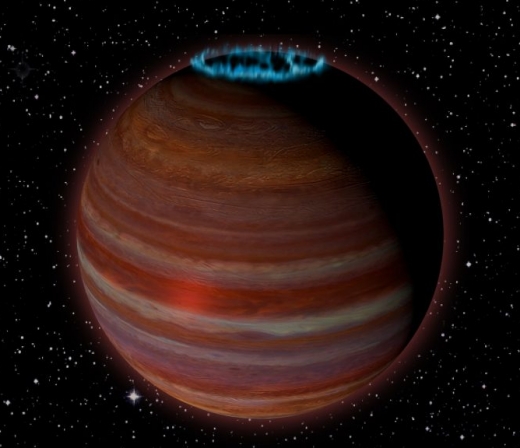Given the spectacular interactions between Io and Jupiter — the moon plays a major role in shaping the planet’s magnetic field and contributes a cloud of particles originally produced by its volcanic activity — it’s all but inevitable that a recently discovered ‘rogue’ object would be compared to the duo. The rogue in question is SIMP J01365663+0933473, a planetary mass object of perhaps 12 Jupiter masses that is at the boundary between brown dwarf and planet. Between 12 and 13 Jupiter masses is considered to be the deuterium burning limit; i.e., above this, we would expect a gaseous object to be a deuterium-burning brown dwarf.
What an intriguing situation we find here. Originally found in data collected by the Very Large Array, SIMP J01365663+0933473 (which I’ll now mercifully shorten, as per the paper, to SIMP0136) has a magnetic field some 200 times stronger than Jupiter’s. The discovery marked the first radio detection of a possibly planetary mass object beyond our Solar System, as well as the first measurement of the magnetic field of such an object. SIMP0136 is presented as part of a broader study examining five known radio-emitting brown dwarfs observed at the VLA.
Some brown dwarfs have previously been found to have auroras, not dissimilar to those we’ve found in our own Solar System’s gas giant planets. But how they are produced here is an interesting question. The spectacular auroral displays that can enliven winter skies on Earth are the result of our planet’s magnetic field interacting with the solar wind. SIMP0136, 20 light years out, is unaccompanied by any star. Thus the Io comparison — we may be looking at an orbiting planet (or moon, depending on what the primary object is) interacting with its magnetic field.

Image: Artist’s conception of SIMP J01365663+0933473, an object with 12.7 times the mass of Jupiter, but a magnetic field 200 times more powerful than Jupiter’s. This object is 20 light-years from Earth. Credit: Caltech/Chuck Carter; NRAO/AUI/NSF.
The lead author of today’s paper on this object is graduate student Melodie Kao, recently at Caltech, and now a postdoc at Arizona State University. Kao points out in this NRAO news release that SIMP0136 can help us understand magnetic processes on both stars and planets. Radio flaring was first observed in a brown dwarf in 2001, providing evidence for strong magnetic activity.
In fact, the original detection of SIMP0136 was as part of a study into brown dwarf magnetic fields and radio emission in cool objects, but SIMP0136 itself was then thought to be considerably older than it turns out to be. Last year an independent team headed by Jonathan Gagné discovered that it was part of the young Carina-Near moving group, and determined that its mass was 12.7 times that of Jupiter, with a radius 1.22 times that of the gas giant. All the brown dwarfs surveyed here turn out to be rapid rotators, with rotation periods between ?1.44 and 2.88 hours. The authors suggest a rotation period of 2.3895±0.0005 for SIMP0136.
At 200 million years old (the projected age of the Carina-Near moving group), with a surface temperature of about 825 degrees Celsius (well below our Sun’s surface temperature of 5,500 degrees C), SIMP0136 looked more and more like a free-floating planet. It should be useful as we examine the production of magnetic fields in both brown dwarfs and exoplanets, along with the auroral activity they can generate. And here’s an interesting follow-up. Are we looking at a new way to detect a particular kind of exoplanet? From the paper:
…SIMP0136…was recently found to be a member of a nearby ?200 Myr moving group. This new age constraint reduces its estimated mass to a mere 12.7 ± 1.0 MJ, possibly making SIMP0136 the first known planetary mass object detected in the radio. If SIMP0136 is indeed a field exoplanet, its detection demonstrates that auroral radio emission can open a new avenue to detecting exoplanets, including elusive rogue planets.
The paper is Kao et al., “The Strongest Magnetic Fields on the Coolest Brown Dwarfs,” Astrophysical Journal Vol. 237, No. 2 (31 July 2018). Abstract / preprint. Gagné and team’s work is Gagné et al., “SIMP J013656.5+093347 Is Likely a Planetary-mass Object in the Carina-Near Moving Group,” Astrophysical Journal Letters Vol. 841, No. 1 (15 May 2017). Abstract available.



Hmm. My earlier comment seems to have been lost in the void.
But I think it’s worth a second go.
The prospect of detecting exoplanet magnetic fields is fascinating. Is this really acheivable for terrestrial planets as the authors have suggested?
The VLA detected cyclotron radiation (emitted by electrons accelerated by the “planetary” magnetic field) from SIMP0136.
The E(xpanded)VLA has a published point source sensitivity of 1 micro Jansky at 12 hours integration. The flux density of SIMP0136 was 15 micro Jy at a distance of 20 ly. An terrestrial Earth equivalent would create a much weaker signal however on the order of 10e-6 the strength. That is well below even the sensitivity of the SKA which is set to be around 10 nano Jy at 8h integration.
Also the detection of the radio signals from SIMP0136 was made vastly simpler because it is a rogue object. The issue of separating weak planetary cyclotron signals from those of a host star was not present.
The authors speculation about a potentially new method of exoplanet detection has significant caveats.
“The flux density of SIMP0136 was 15 micro Jy at a distance of 20 ly”
what’s Jy ???
Jansky, a unit of spectral flux density used in radio astronomy.
Imagine a planet sized mass around one of these BD’s, they are serious trouble with a magnetic field 200 stronger than Jupiter’s ! Jupiter’s interaction with Io is measured at around 2 trillion watts, 200 times that is just off the charts !
This is a little OT, but does involve a “rogue object”, so here goes:”A kinemetical age for the interstellar object 11/`Oumuamua”. by F Almeda-Fernandes, H. J. Rocha-Pinto. I take this with an EXTREME grain of salt, BUT: If the authors ARE right, `Oumuamua is only between 200 to 450 MILLION years old, which means that if it is a comet, it should have out-gassed MUCH MORE MATERIAL than it putatively did, because it is still VERY YOUNG in astronomical terms. ALSO: It would have had absolutely NO TIME to accumulate all of that gunk on its surface. So, if true, we are back to SQUARE ONE!